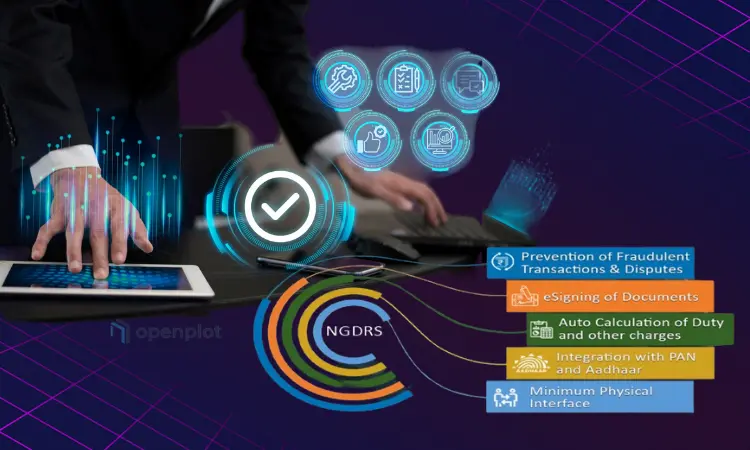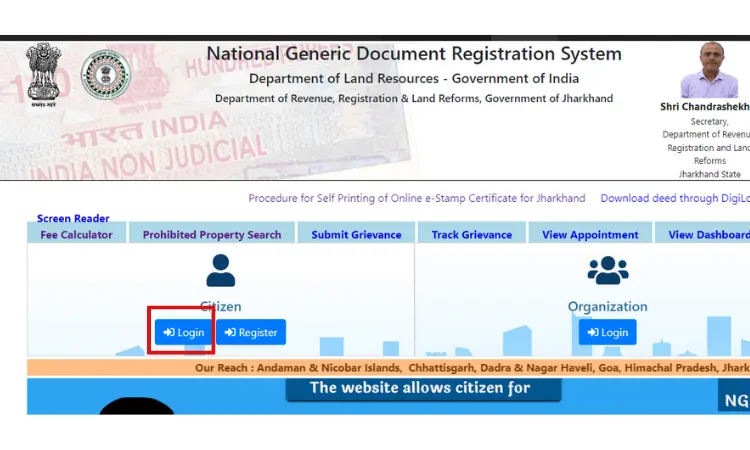Introduction
NGDRS is a centralized system that allows for the registration and verification of various types of documents. Providing a secure and efficient way to maintain important records. It aims to streamline document processing. Ensure the authenticity of registered documents in various government agencies. NGDRS helps reduce paperwork and eliminate the risk of document tampering or fraud.

Table of contents
- Importance of National Generic Document Registration System (NGDRS)
- Key Objectives of the National Generic Document Registration System
- Distinctive Features of the National Generic Document Registration System
- Which States Have Implemented NGDRS?
- Additional States Have Implemented NGDRS
- Process of Registering with NGDRS
- Register a Deed on National Generic Document Registration System (NGDRS)
- Frequently Asked Questions
The National Generic Document Registration System (NGDRS) is citizen-centric software designed for online property registration. It improves transparency and accessibility. They provide information to government officials and the general public. Developed by the Department of Land Resources, Government of India, as part of the Digital India Land Records Modernization Program (DILRMP). It conforms to the specific requirements. NGDRS services like online document entry of citizens, property valuation, and stamp duty calculation are also provided.
Importance of National Generic Document Registration System (NGDRS)
This system allows for efficient and secure registration of various documents. Reducing the likelihood of fraud and errors. NGDRS also streamlines the process for citizens to access and verify important documents. Promoting transparency and accountability in government transactions. It has revolutionized the way documents are registered and accessed.
Providing a reliable and user-friendly platform for all stakeholders involved. Its implementation has significantly improved efficiency. Integrity of document registration processes across different levels of government. The NGDRS is crucial for ensuring the security and authenticity of important documents. Such as property deeds, birth certificates, and contracts. By centralizing document registration.
It helps prevent fraud, simplifies record-keeping, and streamlines access to critical information. It’s providing a reliable way to verify the validity of documents, which is essential for legal and financial transactions. It has also enhanced transparency and accountability in document management processes. By providing a secure and tamper-proof repository for important documents.
Key Objectives of the National Generic Document Registration System
NGDRS aims to ensure that registrations and document deliveries. Occur more quickly and efficiently compared to traditional methods. ultimately saving time and resources for both businesses and individuals. By streamlining the process through digital technology, NGDRS helps to reduce errors. Delays in registration processes lead to a more seamless experience for all parties involved.
- Under DILRMP (Digital India Land Records Modernization Programmed), a central sector scheme to achieve a one-country. The one-software concept for the registration of property transaction deeds and documents across the country.
- Considering India’s diversity of languages and legal jargon, state-specific laws, or statutes. They provide common software across the country to register property transaction documents.
- Provided e-registration or presence less registration with remote authentication.
- Citizens visit the registration departments only with a prior appointment. It reduces the effective registration time.
- Citizen empowerment will be enabled by enabling property valuation and online document submission.
- Maintaining a single platform for all stakeholders in the registration process.]
- Single source code and single data structure across India.
- Custodian of data as per the State IGR Registration Act.
- e-KYC based on party authentication and PAN verification.
Distinctive Features of the National Generic Document Registration System
Include a centralized database for easy access to documents from various agencies and departments. Additionally, the system allows for secure electronic submission and processing of documents. It reduces paperwork and increases efficiency in document registration processes.
- Single source code and single data structure across India.
- Custodian of data as per the State IGR Registration Act.
- e-KYC based on party authentication and PAN verification.
- There is a configurable restriction on the registration of any prohibited property.
- Integration of state-specific digital payment gateways as well as bank payment gateways. Less e-registration with remote e-KYC.
- A paid Tatkal appointment facility is available for urgent registration.
- Template-based e-registration to reduce scanned document space for retrieval in such reports.
- Integration with urban local bodies for property tax.
- Facility for the preparation of the encumbrance certificate.
Which States Have Implemented NGDRS?
The National Guard Domestic Response System (NGDRS) has been implemented in several states across the United States. A total of 31 states and UTs are under NGDRS or e-registration. It has been implemented in 18 states and UTs, namely:
- Andaman & Nicobar
- Assam
- Bihar
- Chhattisgarh
- Dadra and Nagar Haveli & Daman and Diu
- Goa
- Jammu and Kashmir
- Jharkhand
- Himachal Pradesh
- Maharashtra
- Manipur
- Mizoram
- Meghalaya
- NCT of Delhi
- Ladakh
- Punjab
- Tripura
- Uttarakhand
Additional States Have Implemented NGDRS
Additionally, 13 states or UTs have started sharing data with the national portal of NGDRS, or e-Registration. This is done through the user interface or API.
- Andhra Pradesh
- Chandigarh
- Gujarat
- Haryana
- Madhya Pradesh
- Odisha
- Puducherry
- Rajasthan
- Sikkim
- Tamil Nadu
- Telangana
- Uttar Pradesh
- West Bengal
Process of Registering with NGDRS
To register with NGDRS, you will need to provide your personal information. In some cases, you may be required to submit supporting documents to verify your identity and eligibility for registration. The registration form on their state’s NGDRS portal is provided with the following details:
- Username
- Password
- Email ID
- Citizen Type (Indian or NRI)
- State
- Permanent Address
- District
- Captcha Code
Register a Deed on National Generic Document Registration System (NGDRS)
You can register the deed in NGDRS. However, read the guidelines carefully before filling in the property registration details. Here are the step-by-step guidelines. Let’s see.
- Log in to NGDRS.

- Fill in all the details in the General Information.
- Complete the information on the Property Details and Valuation tab.
- Enter the party details and select a party as the presenter.
- Fill in witness details. Make an online payment.
- Calculate the stamp duty. Read the pre-registration summary carefully.
- Upload the required files. Proceed with data submission.
- Fix an appointment with the SRO office.
- Visit the SRO office on the scheduled date for further application processing.
Conclusion
The NGDRS is a centralized platform that allows for the registration and verification of various types of documents. Providing a secure and efficient way to manage important records. Users can access this system to streamline document processing and ensure authenticity. The NGDRS aims to reduce fraud. Improve document security by creating a standardized registration process. It also offers a user-friendly interface for easy navigation and accessibility. For more information, visit openplot.
| Also read Bhumata Portal Replaces Dharani Portal: New Rules for Telangana Land Registration The Telangana State Government has introduced the “New Record of Rights (NROR) Bill 2024” to address the persistent issues plaguing the Dharani portal. This visionary bill aims to amend the RoR Act by introducing a new Bhumata portal in place of the Dharani portal. Yeida Residential Plot Scheme Application for Extend Till August 23 Yamuna Expressway Industrial Development Authority (Yeida) has extended. Yeida Residential Plot Scheme offers a unique opportunity for individuals. To invest in prime real estate in a rapidly developing area. Child-Friendly Environment Developing in Real Estate Child-centric amenities in residential projects play a crucial role in enhancing the overall quality of life for families with young children. These child-friendly environment only provide a safe and stimulating environment for children to play. Nirmala Sitharaman: Property Sales Tax From 20% to 12.5% Reduces Finance Minister Nirmala Sitharaman said property sales tax was reduced by 7.5%. the burden on homebuyers and encourages investment in the real estate sector. This move is expected to stimulate economic growth. Provide relief to both buyers and sellers in the property market. |
Frequently Asked Questions
Q. Who launched NGDRS?
A. A project initiated by the Department of Land Resources, Ministry of Rural Development, Government of India, National Generic Document Registration System (NGDRS) is a simple, common, and configurable application developed for registration departments across the country.
Q. How many states have implemented NGDRS?
A. A total of 31 states and UTs are under NGDRS, or e-registration. It has been implemented in 18 states and UTs.
Q. Who developed NGDRS?
A. The Department of Land Resources has developed the National Generic Document Registration System (NGDRS) as part of the Digital India Land Records Modernization Program (DILRMP).